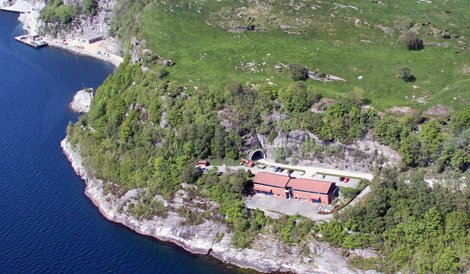Climate change and terror strikes may dominate the headlines but a data center buyer knows that the biggest threat to their wellbeing is the daily struggle against a hidden enemy – the balance sheet. This is why Green Mountain considers its special price-fixing packages its strongest pitch. We may live in an age of extreme weather conditions and terrorism but the electricity bill is still the biggest struggle any data center business will have to deal with today.
Housed in an ex-NATO hideout, carved out of a mountain surrounded by the Fjords of Stavenger in Norway, Smedvig’s data center complex offers a seemingly impregnable fortress against the elements. The 60 meters of stone that sit between the data halls and outside elements mean that business is unlikely to be interrupted by downpours, hurricanes, electromagnetic storms or industrial espionage.
The Fjords in which it sits are not subject to anything more than a few centimeters of tidal fluctuation, and the complicated network of small islands and mountain ranges of south Norway create an effective barrier against tsunamis. Its hollow interior also means the data center’s atmosphere can be controlled easily.
Oxygen levels can be lowered sufficiently (from 21% to 15%) to create a fire-suppressive environment that is still humanly tolerable. Hypoxic air venting suppresses fires and limits smoke creation while minimizing the corrosion from any saline elements in the air.
An oil-rich region
By another happy coincidence, the discovery of oil in the region in the 1970s helped finance investment in green technology and the laying of copious lengths of fiber connections between the oil platforms and Europe. The existing infrastructure of the North Sea oil platforms is now being augmented by a number of carriers, giving clients at least five telco options.
The Green Mountain data center enjoys further advantages in that it can use the surrounding sea water to cool data halls. The brine arrives in the data center at a chilly 8°C after being sourced from 100 meters below sea level. Since salt water is corrosive, the brine is then used to lower the temperature of fresh water in a separate circuit of pipes via a titanium heat exchanger. The cold, fresh water is then piped underneath the racks in each data hall, the chilled pipes lowering the temperature of each aisle.
It is the complicated geography of this region that creates the facility’s biggest competitive advantage: cheap power. The abundance of mountains and high-altitude reservoirs has created so much potential for hydropowered electricity generation that the region can exist entirely on sustainable energy. As a result of this wealth of natural resources, Norway can generate power more cheaply than most other European nations. Surpluses from the national grid are even sold to neighboring countries.
Green Mountain has three independent power stations from which it can source power, so backup generators are hardly a concern, according to CEO Knut Molaug. But he supplies them anyway in order to comply with Tier III Uptime Institute certification.
Eco-friendliness and security are desirable but Molaug says price is still the overriding consideration for most businesses. Britain’s current wholesale power currently costs 12 cents/kWh, while Norway’s is around five cents/kWh. According to UK energy regulator OFGEM, the cost of power will double in ten years as the UK struggles to replace the gap left by coal and nuclear power. Germany will be paying 45% more for its power than Norway in 2015, according to research by consulting engineers Econ Poyry.
Price stability
Green sources of sustainable power mean the data center will be able to boast a low power usage effectiveness. But it’s the predictability of this supply that will impress the hard-nosed CFOs that sign off most contracts, Molaug says.
This is why Green Mountain’s management have put together a series of financial packages that guarantee the stability of power prices for up to ten years. The relative cheapness and stability of Norway’s power supply has enabled Smedvig, the owner of Green Mountain, to offer long-term power contracts with fixed costs. A three-year contract (from 2013 to 2105) is priced at €37.5 per MWh. Customers that can commit to a ten-year contract will find they will pay €41 per MWh, for a whole ten years – and who knows how high the price will be in the UK by that time?
This article first appeared in FOCUS magazine, Issue 30, available online now. Click here to see the digital edition and find out more about the software-defined data center.

